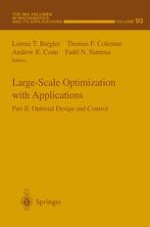This IMA Volume in Mathematics and its Applications LARGE-SCALE OPTIMIZATION WITH APPLICATIONS, PART II: OPTIMAL DESIGN AND CONTROL is one of the three volumes based on the proceedings of the 1995 IMA three week Summer Program on "Large-Scale Optimization with Applications to Inverse Problems, Optimal Control and Design, and Molecular and Struc tural Optimization." The other two related proceedings appeared as Vol ume 92: Large-Scale Optirpization with Applications, Part I: Optimization in Inverse Problems and Design and Volume 94: Large-Scale Optimization with Applications, Part III: Molecular Structure and Optimization. We would like to thank Lorenz T. Biegler, Thomas F. Coleman, An drew R. Conn, and Fadil N. Santosa for their excellent work as organizers of the meetings and for editing the proceedings. We also take this opportunity to thank the National Science Founda tion (NSF), the Department of Energy (DOE), and the Alfred P. Sloan support made the workshops possible.
